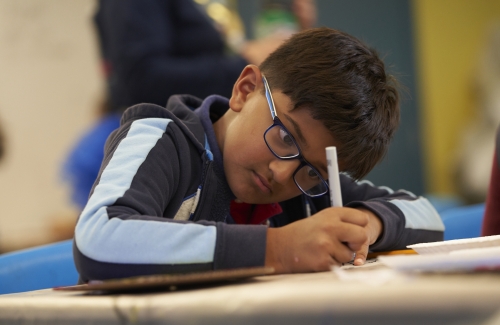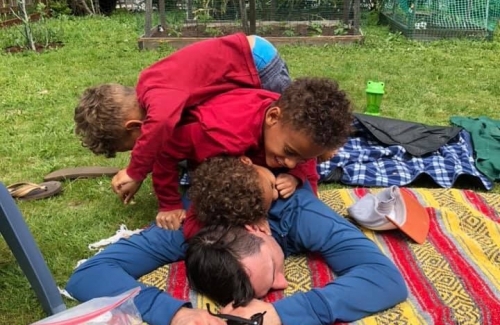Gratitude Activities for Kids and Parents

It’s no wonder why Thanksgiving is a favorite among the host of holidays—any day that emphasizes food, family, friends and fun is sure to be a hit.
Beyond decadent dishes and family traditions, Thanksgiving can also be a wonderful reminder of the things for which we are thankful. This annual holiday provides the perfect opportunity to refocus as a family, to express our thanks, and to share some gratitude activities with kids.
The Benefits of Gratitude
Gratitude—that feeling and expression of appreciation for the good in our lives—is actually good for us. The benefits of this often-researched emotion can have profound effects on our lives. Besides giving us a sense of well-being as we come to appreciate what we have, gratitude can increase optimism, empathy, and happiness.
Physical Health
Being grateful for what we have helps us to overcome negative feelings. It also prompts us to take better care of ourselves, as we tend to be more optimistic about our longevity. The benefits may extend to stress levels, blood pressure, and the immune system.
Psychological Well-Being
People focused on gratitude have less room for negative emotions and thus see more of the positive in their lives. A study that measured brain activity objectively via magnetic resonance imaging (MRI) demonstrated that gratitude has long-lasting positive effects on the brain, suggesting improved mental health over time.
Sleep
Preliminary research into the connection between gratitude and better sleep suggests a correlation. When people fill their pre-sleep period with positive thoughts, such as writing in a gratitude journal, it may have a soothing effect on the nervous system, quieting the mind and easing the transition from wakefulness to sweet dreams.
Relationships
Beyond the fact that it is good manners, acknowledging another person’s kindness or goodwill with thanks strengthens and perpetuates the bonds between us. Gratitude increases prosocial behaviors—those which help us to build and maintain meaningful relationships with others.
Practicing Gratitude as a Family
The holiday season’s focus on giving thanks provides families with natural opportunities to get involved in expressions of gratitude. These can be informal and impromptu or pre-planned and rehearsed. The important thing is to model gratitude and share it with kids so that you can reap the benefits as a family.
Talk About Gratitude as a Family
Seizing this teachable moment to elaborate on gratitude gives each family member the opportunity to express their thanks outwardly. A fun way to do this is to incorporate these expressions into the holiday table decorations. Kids could prepare color-coordinated strips of construction paper and magic markers to present to each family member. Each person would record something for which they are thankful on their strip. Kids can then loop the strips together, creating a paper chain with which to decorate the eating area.
Gratitude Letters
There’s something very tangible about putting gratitude on paper, regardless of whether the letter is delivered or not. Try a gratitude letter-writing activity to express gratitude for someone who has been kind or helpful to your family, then consider putting your note in the mail. Modeling appreciation in this way is a visible representation of gratitude in real life.
Learn About the Thanksgiving Address
November is Native American Heritage Month, and Native Americans figure prominently in our Thanksgiving lore. But rather than focusing on historical accounts, why not learn about how some First Nations and Indigenous communities voice regular expressions of gratitude today.
The Haudenosaunee open and close every gathering or social event with the Thanksgiving Address, which teaches gratitude, mutual respect and conservation. It promotes eco-consciousness and responsibility by reminding them of their connection to the natural world. Read through it as a family, perhaps with each family member taking a part. Continue the conversation with discussions of how we might conserve and sustain our planet.
Share Gratitude Stories
What better way to learn about gratitude than through a shared read-aloud? Pre-kindergarteners through 3rd-graders might enjoy Gratitude Soup, Grateful: A Song of Giving Thanks, or The Giving Tree, while older kids will appreciate Thanks a Million, a poetry anthology by Nikki Grimes. Giving Thanks provides a kid-friendly version of the Haudenosaunee Thanksgiving Address. Be sure to talk about the stories afterward, so kids can make connections with their own experiences.
Consider the Emphasis on Food
This food-focused holiday is a natural opportunity to discuss food insecurity in your local community and around the world. Involve kids in action-oriented activities, such as making a donation as a family to a local food bank or pantry. Allowing kids to contribute part of their allowance or raise money to help out helps them turn compassion into action.
To impact hunger farther from home, think about supporting an organization like A Well-fed World (AWFW). Through four options for gift-giving, Plants-4-Hunger allows donors to support sustainable vegan feeding and farming. Since animal farming is a top greenhouse gas producer, getting involved with AWFW can potentially impact world hunger, humane treatment of animals, and climate change—quite the win-win.
Making Gratitude a Daily Practice
Sincere gratitude has an impact on kids and parents alike. With so many benefits, it definitely makes sense to work gratitude into our daily lives and encourage our kids to do the same. The Thanksgiving season is an ideal opportunity to introduce this practice and emphasize the positive aspects of life. Making time for gratitude activities with kids not only strengthens family bonds, but will establish a mindset of appreciation and a healthy foundation for the mental, physical, and emotional self.

 Introducing: Fall Break Classes at Galileo Anywhere
Introducing: Fall Break Classes at Galileo Anywhere  3 Ways to Celebrate Long-Distance Friendship
3 Ways to Celebrate Long-Distance Friendship  I Like the Way You Family: 10 Ways to Grow Closer Together
I Like the Way You Family: 10 Ways to Grow Closer Together 